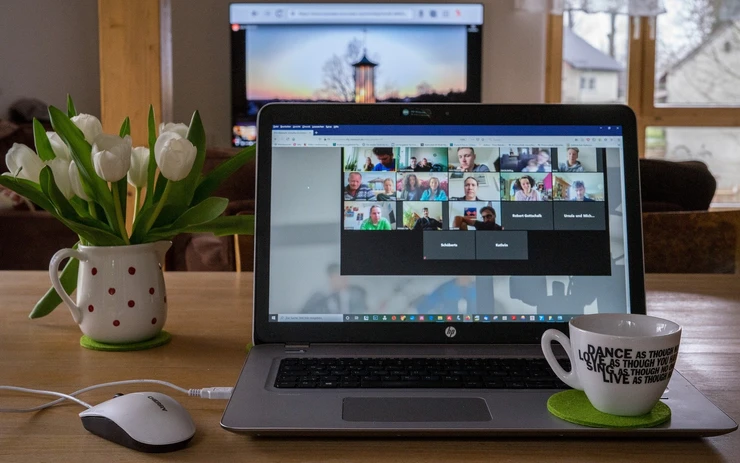5 Virtual Events Audience Engagement Ideas
Before 2020, many of us event planners had dabbled in webinars and small virtual events. But I don’t think any of us could have predicted how critical virtual meetings would become for our businesses in 2020. During COVID-19, most organizations have pivoted their in-person meetings to virtual meetings, with more and more adding them to their long-term events strategy.
One thing about virtual events is that it can be very easy to forget you have an audience you need to engage and entertain. After all, you’re sitting at home alone right? It’s easy to hide behind the screen and forget there are people on the other side. There are so many little things you can do to make sure your virtual meeting is more engaging.
Here are our top tips for running an engaging virtual meeting that will create impact for your company!
1. Set the Mood with Music & Icebreakers
You want to set the stage for the virtual meeting with energy, passion, and of course, a super fun playlist.
Do you have a pump-up playlist you listen to when you get ready in the morning or before a big presentation? Did you play walk-in music at your in-person conferences? It’s the same thing in virtual meetings. As attendees start to log on have that pump up playlist streaming in the background to elevate the mood and get people excited.
Many companies have been using funny, but appropriate, videos to break the ice in the beginning. Something light and happy like The Office or Parks & Rec. references are always a hit.
You can even start with some poll questions so the participants can get to know who else they’re on the call with that day (more on this later!), or a virtual team building activity.
2. Make it a Lunch Meeting
When we hosted meetings in-person, a highlight for most was conversing over lunch. Why not bring lunch to your meeting attendees? There are a ton of catering companies that are thinking “in the box” these days!
Many caterers are creating curated culinary boxes that provide attendees with a branded lunch box delivered right to their door, or available for to-go pre-meeting. Some companies are even creating meal box options where a professional Chef will lead your group through a guided cooking lesson. Start your meeting with a cooking class and then discuss all the important things over a meal together! It’s a great way to get people interacting and conversing.
3. Include Gamification Features
For many people, gamification may be new. You may be asking, “What is gamification exactly?”. Well, gamification is exactly what it sounds like, fun little games or challenges inserted strategically into the meeting. A few ideas for gamification are:
- Who Said That – Collect quotes from speakers and participants during the meeting. At the end, do a series of “Who Said That” and see if participants can guess.
- Trivia – Who doesn’t love trivia? It’s the perfect friendly competition and you can theme it around meeting objectives.
- Scavenger Hunts – Curate a list of things you’d like your attendees to keep an eye out for, or tasks you want them to complete on your app during the meeting. Whoever checks off the most wins!
There are so many fun ways to get attendees involved throughout the duration of the meeting and keep attention while enhancing participation.
4. Don’t Forget Polls
If you don’t ask questions or encourage participation, you’re going to lose people. Think back to your college days when the professor stood up front and read off the Power Point slides. Did you get much value out of that? No, you learned and paid attention when the teacher asked questions throughout the class and kept the energy high with a little friendly competition. With meetings, it’s the same thing!
Pop polls in for everything, from the icebreaker in the beginning to questions about meeting content at the end. Polls are a powerful tool to engage during any point of the meeting. Pro tip: Prizes make them even more fun and engaging!
Here are a few great ideas for questions if you don’t know where to begin!
5. Get Them Moving
Just like an in-person meeting, you don’t want your virtual meeting attendees falling asleep on you, right? During breaks, or as a planned activity during the meeting, incorporate some simple movement!
There are so many companies like Office Meet Yoga that are now offering virtual yoga breaks.
The University of California Irvine released a healthy meetings guide with effective chair stretches perfect for a quick break.
Just shake it out and keep energy levels high!
If you’re worried about Zoom fatigue at your next virtual event, give us a call to learn about our best audience engagement tactics.
Need Help?
If you need assistance brainstorming ways you can take your virtual meetings to the next level, whether for your team or your clients, we can help. Our team is experienced in producing virtual meetings of all sizes, on multiple platforms, and we’ve perfected the art of making it fun! Get in touch and let’s get to business (virtually).
Share This Post
Explore More Relevant blog Posts

How to Plan the Ultimate Holiday Party for Your Team
The holiday season offers a perfect opportunity to celebrate achievements, foster camaraderie, and show appreciation for your team’s hard work. However, creating a successful corporate

Gratitude In Business: How to Show Appreciation to Clients & Partners
Planning and executing a corporate event is no small feat, but with the right tools, you can ensure everything runs smoothly. From setting up equipment





